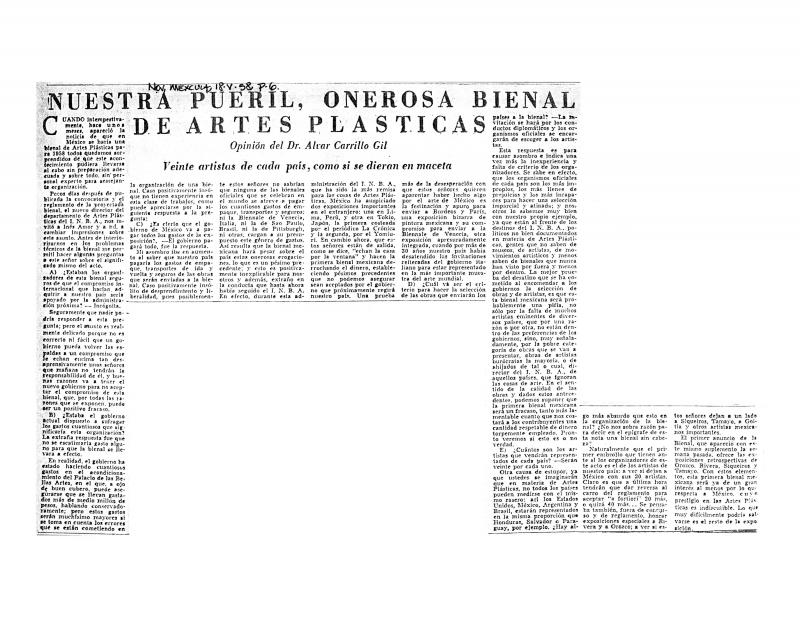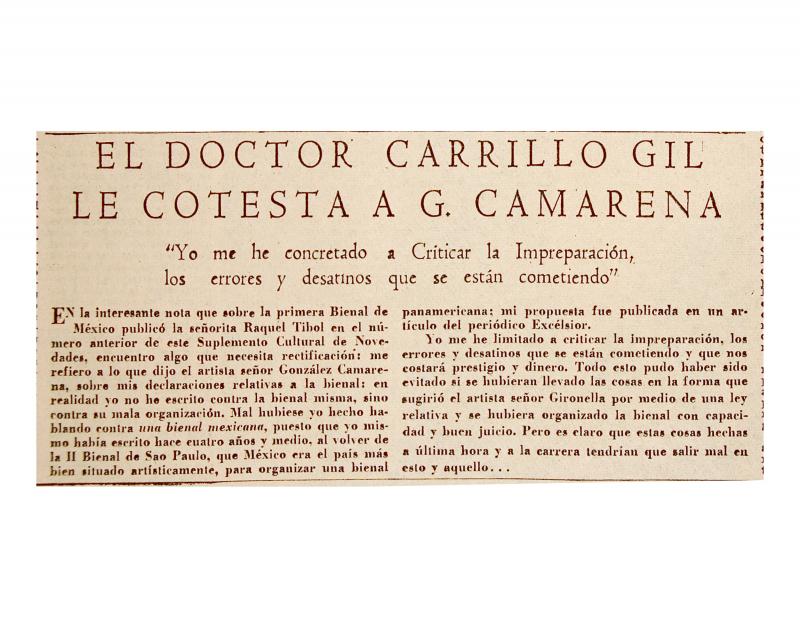Alvar Carrillo Gil (1910–1964) had already published a criticism of the public officials and the organization of theFirst Inter-American Biennial of Painting and Printmaking (See doc. 770451: Alvar Carrillo Gil, "Nuestra pueril, onerosa Bienal de Artes Plásticas" [Our Puerile, Onerous, Visual Arts Biennial], “México en la cultura”, Novedades supplement, May 18, 1958). He had also explained to the painter Jorge González Camarena (1908–1980) that he was not opposed to the event; he even recalls that upon his return from the São Paulo Biennial, he had published the idea of organizing a Pan-American exhibition in Mexico. (See doc. 758347: Alvar Carrillo Gil responds to G. Camarena, “México en la cultura,” Novedades, June 1, 1958). It seemed to him that everything had been done in a rush, on the run, and that was why things didn’t pan out. To the collector, the statements of the director of the Instituto Nacional de Bellas Artes (INBA) were offensive, since in prior years, he had been on good terms with the government. Even the museologist Fernando Gamboa had made a selection from his collection, choosing the best works of Orozco and Siqueiros, which the collector had lent for exhibition at the Brussels World’s Fair (1958). Because he was one of the most important private collectors in Mexico, Carrillo Gil felt he had the moral authority to make a direct criticism of the public officials, whom he considered opportunistic and bureaucratic. Miguel Álvarez Acosta, director del Instituto Nacional de Bellas Artes (1954–58), and Miguel Salas Anzures, head of the Departamento de Artes Plásticas [Visual Arts Department] (1957–1961) of the INBA y Literatura (INBAL), organized the two biennials held at the Museo Nacional de Artes Plásticas (Palacio de Bellas Artes). The first biennial (June 6–September 30, 1958) was organized around four masters—a tribute dedicated to José Clemente Orozco, Diego Rivera, David Alfaro Siqueiros, and the Brazilian Candido Portinari. At this biennial, there was general discontent due to the organization and the unwanted participation of the Frente Nacional de Artes Plásticas on the jury. At the second biennial, held in 1960, many artists, such as José Luis Cuevas, Francisco Icaza, and Arnold Belkin, among others, did not participate, in protest against the imprisonment of David Alfaro Siqueiros (1896–1974) at Lecumberri jail in Mexico City. Participation in both exhibitions included countries such as: Argentina, Bolivia, Brazil, Canada, Colombia, Costa Rica, Cuba, Chile, the Dominican Republic, Ecuador, the United States, El Salvador, Guatemala, Haiti, Honduras, México, Panamá, Paraguay, Peru, Puerto Rico, and Venezuela. The official name of the Biennial and the name most used was the “Bienal Interamericana de Pintura y Grabado” [Inter-American Biennial of Painting and Printmaking], although other coinages were in circulation, such as the “Bienal de Artes Plásticas” [Visual Artes Biennial], and the “Bienal Panamericana de Pintura” [Pan-American Painting Biennial.]


